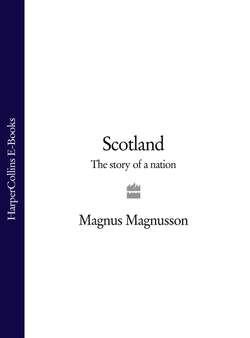Читать книгу Scotland: The Story of a Nation - Magnus Magnusson - Страница 11
Skara Brae, Orkney (3100–2600 BC)
ОглавлениеIn the winter of 1850 a ferocious storm stripped the turf from a high sand-dune known as Skara Brae in the Bay of Skaill, on the west coast of mainland Orkney. An immense midden was exposed, as well as a semi-subterranean warren of ancient stone buildings. What came to light in that storm turned out to be the best-preserved prehistoric village in northern Europe. And not only was it perfectly preserved – it was the earliest in Europe as well: the village of Skara Brae was inhabited around 3100 BC, more than half a millennium before the Great Pyramid of Egypt was built (2500 BC), and long before Stonehenge (2000 BC).
A splendid new £900,000 Visitor Centre was opened in April 1998. It had taken ten years to plan and build, and it provides a graphic introduction to the story of Skara Brae, using interactive computer images and a replica of one of the original stone houses. But nothing can match the extraordinary experience of seeing the place for oneself.
The ‘village’ comprises half a dozen separate houses and some associated structures, including a very large workshop for manufacturing stone tools. The houses are spacious and cellular, connected by covered passage-lanes. The village was deliberately embedded into the congealed mass of the midden up to roof height, to provide stability and insulation. The walls were made of local Orkney flagstone, which is easily worked and splits naturally into building slabs. All the fittings and furnishings were also fashioned from flagstone – the kitchen dressers, the cupboards, the shelves, the compartments for the beds. Some of the houses had under-floor drains for indoor sanitation.
The houses are roofless now. Visitors walk along the tops of the walls and look down into the interiors of the houses. There is a startling sense of intimacy, peering down into these comfortable, well-furnished homes: it is easy to imagine the families who lived there for some twenty generations, from 3100 to 2600 BC. The village evokes a vivid sense of immediacy, of instant identity with that close-knit, self-sufficient farming and fishing community.
They lived well. The womenfolk owned a lot of jewellery (necklaces, pendants and pins made from bone, as well as ivory and pumice) which they kept in a recess above the bed. They cooked with home-made pottery on a square stone-built hearth in the centre of the room. Farming consisted of keeping cattle and sheep and a few pigs, and growing barley; the sea provided cod and saithe, lobsters and crabs, cockles and mussels. The nearby cliffs were a cornucopia of seabirds’ eggs. Wind and weather drove whales, dolphins, porpoises and walrus ashore on their doorstep.
It was a stable, unchanging lifestyle. Then the village was deserted, around 2600 BC – no one knows how or why. There is no archaeological evidence of sudden emergency or destruction.
The merging of the Neolithic Age into the Bronze Age also saw the flowering of an extraordinary architectural phenomenon – the erection of stone circles and standing stones. On Orkney, not far from Skara Brae, the Standing Stones of Stenness and the Ring of Brogar survive. But the most imposing, and probably the oldest, of the megalithic (‘big stone’) monuments of Scotland is the great complex at Calanais on the Isle of Lewis – Scotland’s ‘Stonehenge of the North’.
